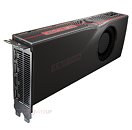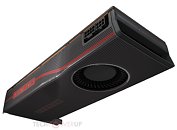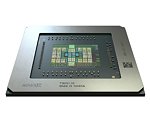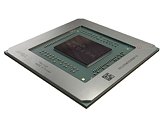Tuesday, June 11th 2019

AMD Radeon RX 5700 XT, RX 5700 & Navi 10 GPU Chip Pictured Up Close
Here are some of the first clear pictures of the Radeon RX 5700 XT and RX 5700 AMD launched on Monday. The two cards are based on the new 7 nm "Navi 10" silicon that implements AMD's latest RDNA architecture. The reference-design RX 5700 XT sports a brand new premium design with a ridged metal cooler shroud studded with an illuminated Radeon logo on top, a second logo at its front face, and a matching back-plate. Underneath is an aluminium fin-channel heatsink with a vapor-chamber base-plate that pulls heat from the GPU, memory, and VRM. A lateral-flow blower ventilates the heatsink, pushing hot air out of the case. Power is drawn from a combination of 8-pin and 6-pin PCIe power connectors. Outputs include three DisplayPort and one HDMI.
The Radeon RX 5700 looks a little less premium, and its cooler design greatly resembles the "metal" reference cooler of the RX Vega 64. This is possibly because reference RX 5700 will not make it to the market unlike reference RX 5700 XT, and will instead be an AIB partner-driven launch, with all cards being custom-design. AMD also provided images of the RX 5700 XT in a "teardown" shot, which reveals the vapor-chamber based heatsink, the lateral blower, and more importantly, the reference-design PCB with its 7-phase VRM.More pictures follow.
Here are some close-ups of the 7 nm "Navi 10" ASIC. You may notice the RX 5700 (non-XT) having two 8-pin PCIe connectors. This is probably an error on the part of the artist behind the render. The RX 5700 is a partner-only launch, which means all cards will be custom-design.A quick refresher on the specifications of the RX 5700 XT and the RX 5700. We are working on an architecture deep-dive.
The Radeon RX 5700 looks a little less premium, and its cooler design greatly resembles the "metal" reference cooler of the RX Vega 64. This is possibly because reference RX 5700 will not make it to the market unlike reference RX 5700 XT, and will instead be an AIB partner-driven launch, with all cards being custom-design. AMD also provided images of the RX 5700 XT in a "teardown" shot, which reveals the vapor-chamber based heatsink, the lateral blower, and more importantly, the reference-design PCB with its 7-phase VRM.More pictures follow.
Here are some close-ups of the 7 nm "Navi 10" ASIC. You may notice the RX 5700 (non-XT) having two 8-pin PCIe connectors. This is probably an error on the part of the artist behind the render. The RX 5700 is a partner-only launch, which means all cards will be custom-design.A quick refresher on the specifications of the RX 5700 XT and the RX 5700. We are working on an architecture deep-dive.












54 Comments on AMD Radeon RX 5700 XT, RX 5700 & Navi 10 GPU Chip Pictured Up Close
The sad thing is that this is an opportunity of AMD to move gaming along, deliver slighter better performance at a lower price point and boom, no brainer sales.
as is, its fine but no more interesting then what Nvidia has been offering for a while now.
The good news is that there actually will be competition... and AMD might even be able to make a profit... meaning there will be more competition in the future.
jcmit.net/memoryprice.htm
But I'm pretty sure no one is forcing anyone to buy ram that is significantly cheaper than it was just 10 years ago.
To get the same performance years ago it would have cost significantly more than now.
Once TSMC can really open-up and fully provide to AMD/RTG, especially now that Nvidia is seen as "second string" player at the foundry given their "bài bài la" to TSMC and their moving to Samsung. Just means more openings for AMD/RTG wafer starts. Once we see that tipping point AMD/RTG will have more leeway to get in and price aggressively (which we all know they do). If Polaris can be sold with 25% reduction I can see why once AMD/RTG is over the initial market surge and production levels, prices will make folks take notice. I could think by Black Friday a RX 5700 could see a $330 price.
Forget Nvidia if they keep to their same-old playbook, Navi will bring the influx of sales and margins soon enough, good place to be.
Lisa Su: *enters the room* *examines the ruined prototype* I like it. Send it for production
Radeon team:
2012 - www.techpowerup.com/gpu-specs/radeon-hd-7770-ghz-edition.c308 - Launch Price 159 USD
2019 - Radeon RX 5700 - Launch Price 379 USD
That's an 138% markup on a mid-range card in 5 years.
11%
Inflation eh ?
Why people are defending these greedy corporations, I have no idea. The level of insanity in the world is reaching stratospheric levels.
$249-> $379 = 52% increase, so 40% more than "Inflation".
What will happen next ? Well, nGreedia can continue to jack up prices, and AMD will then follow, because why not ?
Cartels are illegal, btw...
BTW - AMD/RTG is not a charity! And now on a cutting edge process! They've sat back and been patient in their past/place, now they're shaking off that old stigma and this is what competition looks like. I'm willing to let them build a head of steam and see how they run with it.
We aren't talking vacuum cleaners here, there are Billions of transistors in a new 7nm process, with 8GB of GDDR6 and new display outputs, a redesigned video section. This isn't a bar drink, cup of coffee, or scrambled eggs, they at least spent the afternoon designing it....
If you don't like it, don't buy it, anything is worth what the buyer will pay. If they don't sell then you were right, if the do, you are wrong. I think they are going to sell, but I will wait to see how they perform and if the extra features tens of thousands of hours spend creating are worth it to me.
By this logic, we should pay several million dollars for a GPU by now, as today's GPUs are probably over 10000 times faster than an S3 Virge or Matrox Mystique.
You've been brainwashed by the marketing "We have so much moar transistors cr4p in this chip and it's faster, so it MUST be more expensive"
That's not how it works dude.
Faster new gen replaces slower old gen, for same amount of money (+/-). That's how performance is pushed across the board...
But today what we have is a duopoly with a strong Cartel smelly odor... and no more crypto boom to blame.
Let's say that NV had their raytracing bs excuse for jacking up prices.
But what's AMD's excuse ? They aren't giving anything new... just a node shrink a bit more Mhz.
The chip itself is smaller. It should be CHEAPER than Polaris, not more expansive.
I hope the market punishes them by nobody buying these... but that's not happening because people do want faster GPUs, and there's just no choice anymore.
Overpriced or Overpriced. Take your pick.
Bleh...
I'm bidin' my time until the NDA/Reviews give a full picture. In the meantime reading the RTX 2070 Founders Edition Review discussionand honestly looking at how 3 pages of respondents received that Factory Reference card for $600, a reference RX 5700 XT at $449 is more what those comments "at that time" clamored for.
My Cirrus logic card back in the day with its whopping 2MB of video memory sure didn't hardware accelerate and sharpen videos..... Cars also didn't used to have A/C. Why aren't cars getting cheaper, they only used to cost bla bla bla.
If you don't understand market dynamics, supply and demand, investment cost, profit and loss I feel bad for you son, maybe Venezuela offers an answer you seek.
AMD is apparently so "greedy" they almost went bankrupt. And even lately they've had to sell cards for much smaller margins than Nvidia. If they get in a pricing war with Nvidia to try and gain back market share too fast, they will lose... and then we'll have a monopoly again.
All this sadly necessitates price increases to a certain degree. Adding more components (in various senses of the word) will always cost more than replacing components with better-performing like-for-like upgrades. Then there's not only inflation (which is rather trivial on time scales like these) but also other cost increases - after all, one of the necessities of a capitalist "eternal growth" system is that wages and costs rise in lockstep (otherwise you'd run out of potential new customers for your goods), meaning that price increases (at least for consumer goods) normally outstrip inflation alone.
Does this legitimize the price hikes we've seen over the past two generations? No. They're excessive, and significantly so. But some increase is to be expected.